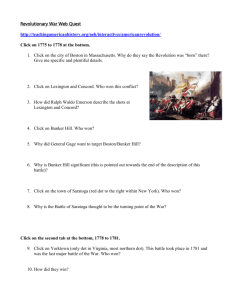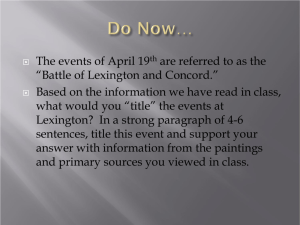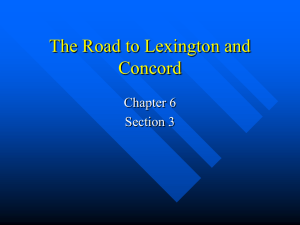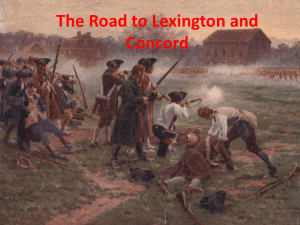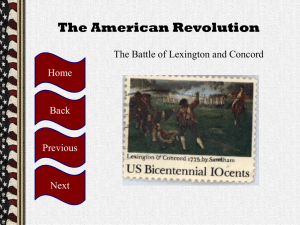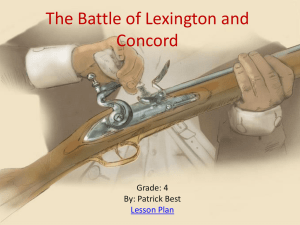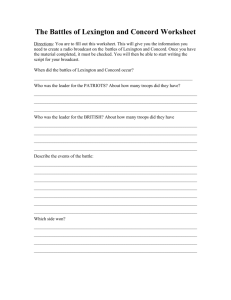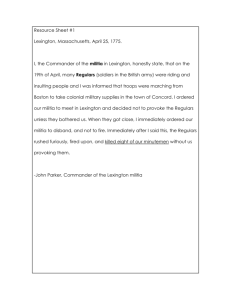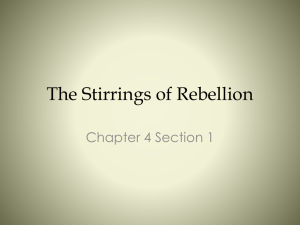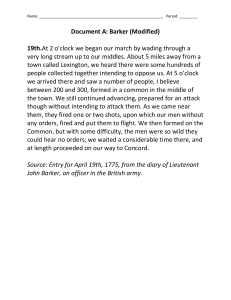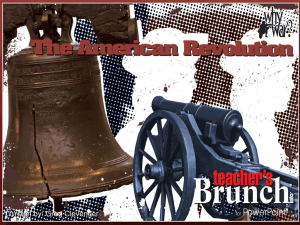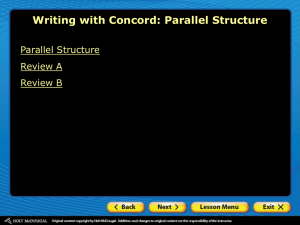Chapter 5 The Spirit of Independence (1763
advertisement
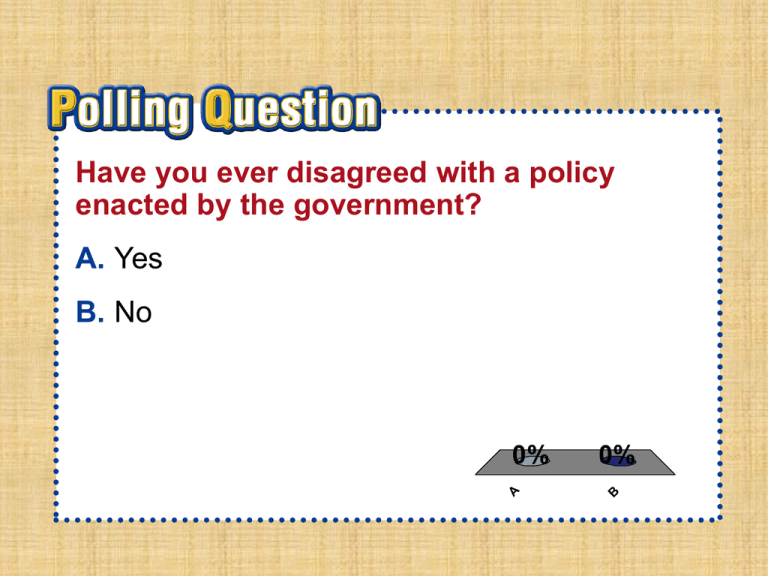
Have you ever disagreed with a policy enacted by the government? A. Yes B. No A. A B. B 0% A 0% B Chapter 5 The Spirit of Independence (1763-1776) Section 3 A Call to Arms What brought about the clash between American colonists and British soldiers at Lexington and Concord? The Continental Congress • September 1774, 55 delegates from the colonies (except Georgia) met • In Philadelphia • Met to represent American interests and challenge British control • Called the Continental Congress The purpose of the Continental Congress was to accomplish which of the following tasks? A. Support British rule B. Explore a new continent C. Challenge British control D. Establish a new boycott 0% A A. B. C. 0% D. B A B C 0% D C 0% D Delegates to the Congress • Massachusetts sent Samuel Adams and his cousin John Adams • New York sent John Jay • Virginia sent Richard Henry Lee, Patrick Henry, and George Washington • Patrick Henry said “I am not a Virginian, but an American” Decisions of the Congress • The Delegates drafted grievances calling for a repeal of the acts • Said the laws violated their rights • Voted to boycott British trade • Decided to endorse the Suffolk Resolves • Called for people to arm themselves against the British • People formed militias (groups of citizen soldiers) Training Militias • Mostly in New England • Had training sessions • Made bullets • Stockpiled rifles and muskets • Minutemen were ready to fight on a minute’s notice Britain Sends Troops • King George said the New England Colonies were “in a state of rebellion” • George realized that fighting was going to happen • By April 1775, several thousand British soldiers were in and around Boston • Many more were on their way • Under the command of Thomas Gage, the British were to take the weapons of the militias • Also arrest the leaders Militia Weapons • Gage learned that the weapons and ammunition was at Concord • About 20 miles northwest of Boston • Lieutenant Colonel Francis Smith and 700 troops were sent to Concord • “Where you will seize and destroy all the artillery and ammunition you can find” Alerting the Colonists • On the night of April 18th, 1775 Dr. Joseph Warren saw the British begin to march out of Boston • Warren told Paul Revere and William Dawes (Both members of the sons of liberty) • They rode to Lexington to warn Samuel Adams and John Hancock • “The British are coming” “The regulars are out!” • Adams said “What a glorious morning this is!” ready to fight for independence The Redcoats March On • At dawn the Redcoats approached Lexington • 70 minutemen were there led by John Parker • Minutemen stood on the town common with muskets in hand • The British yelled “Throw down your arms, ye villains, ye rebels!” The Shot Heard Round The World • Somebody fired, then both sides exchanged bullets • 8 minutemen were dead • The British troops moved to take the ammunition, but most had already been moved • They destroyed the remaining supplies • At Concord’s North Bridge, the Minutemen turned back the British Where did the first battles of the Revolution take place? A. Boston and New York B. Washington and Philadelphia C. Suffolk and Charlestown D. Lexington and Concord 0% A A. B. C. 0% D. B A B C 0% D C 0% D Marching Back to Boston • Blacksmiths, farmers, clerks, and others hid behind trees and stone fences • The militia fired at them as they marched • By the time they reached Boston, at least 174 were injured and 73 were dead • The battle for independence had begun Benedict Arnold • Commander of the Connecticut militia • Was authorized to take Fort Ticonderoga on Lake Champlain • Ticonderoga had needed military supplies • Ethan Allen helped with this attack with his Green Mountain Boys • They caught the British by surprise and they surrendered the fort on May 10th Building Forces • Committees of Correspondence sent out calls for volunteers (helpers) to join the militias • The colonial militia was about 20,000 strong • The British and Colonists waited for who would make the next move The Next Move • June 16th, 1775 about 1,200 militiamen under William Prescott • Set up fortifications at Bunker Hill and Breed’s Hill across the harbor from Boston • The British decided to take the hill • Colonel Prescott said “Don’t fire until you see the whites of their eyes” Battle of Bunker Hill • William Howe with 2,200 men • Crossed by boat to the beaches below Breeds Hills • Formed assault lines • Guns ready, drums beat, marched up the hill • 15 paces away the Patriots began firing More of the Battle of Bunker Hill • Twice the British rushed the hill • Twice they were turned back • American gunpowder ran out • British took the hill • Patriots viewed this as a victory • Over 1,000 redcoats were killed or wounded- 400 Patriot casualties • Patriots held its own against the world’s most powerful army • The British learned that defeating the Americans would not be quick or easy Which of the following shows the correct chronology? A. Bunker Hill, Lexington, Ft. Ticonderoga B. Concord, Yorktown, Lexington 0% 0% D 0% B A 0% C A. A B. B C. Yorktown, Lexington, Concord C. C D. Lexington, Ft. Ticonderoga, BunkerD. HillD Choosing Sides • Americans had to make a choice • Join the rebels or remain loyal to Great Britain • Those that stayed with the British were called Loyalists • Those that sided with the Minutemen were called Patriots • This war was not just between the British and the Americans, but a civil war between the colonists • Patriots against Loyalists What brought about the clash between American colonists and British soldiers at Lexington and Concord? -Americans were arming themselves and expected an armed confrontation with British troops. -The British gave the Americans an excuse to confront them when British soldiers were ordered to march to Concord and seize artillery and weapons. Chapter 5 Section 3 Quiz Who said that "blows must decide" who would rule America? George III Edward III Philip III James III Ja m es III III Ph ili p III w ar d Ed eo rg e III 25% 25% 25% 25% G A. B. C. D. Who had orders to take away the weapons of the Massachusetts militia? A. George Washington B. William Dawes C. Thomas Gage D. Paul Revere G eo er e Re v ag e Pa ul G om as Th m ill ia W rg e W as hi n Da w gt on es 25% 25% 25% 25% ill ia W rg e eo G m hi n W as om as Th Da w gt on ag e G da m s A hn Jo es Who, along with Paul Revere, warned John Hancock and Samuel Adams that the British were coming? A. John Adams 25% 25% 25% 25% B. Thomas Gage C. George Washington D. William Dawes do W al al ph R er s Em hi n W as rg e eo G on . gt on . lle A n Et ha Pa ul Re v er e. n. The Green Mountain Boys, who captured the British-held Fort Ticonderoga, were led by A. Paul Revere. 25% 25% 25% 25% B. Ethan Allen. C. George Washington. D. Ralph Waldo Emerson. on . of at tle B B at tle of Le xi Co n Bo s of at tle B ng t to n co rd . . ill . rH ke Bu n of at tle B. C. D. B A. The British learned that defeating the Americans would not be easy after the British won the Battle of Bunker 25% 25% 25% 25% Hill. Battle of Boston. Battle of Concord. Battle of Lexington. Participant Scores 0 0 Participant 1 Participant 2 0 0 0 Participant 3 Participant 4 Participant 5 Team Scores 0 0 Team 1 Team 2 0 0 0 Team 3 Team 4 Team 5
